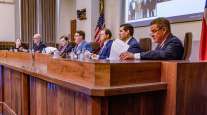The Hour (Norwalk, Conn.)
Connecticut Eyes Vote on Heavy Trucks Toll

[Stay on top of transportation news: Get TTNews in your inbox.]
HARTFORD, Conn. — As hundreds of people filled the Legislative Office Building on Jan. 31 to loudly proclaim their position on tolls, two top Democrats and Gov. Ned Lamont gathered under the gold dome nearby and resolved to adopt the plan within two weeks.
The two scenes played out simultaneously, a crescendo in a yearlong effort to put tolls on Connecticut highways that has become the most controversial state issue since the repeal of the death penalty in 2012.
Legislative leaders, exiting the governor’s office, said they will vote during the week of Feb. 10 on the measure to toll heavy trucks at 12 locations, despite tension among lawmakers over whether the House or Senate should hold the politically tough votes first. Less than 24 hours earlier, a plan to vote Feb. 3 or Feb. 4 had collapsed.
The long-awaited public hearing began in the early afternoon with a presentation from the Office of Policy and Management and the Department of Transportation, while citizens in the restless crowd waited patiently for their three-minute turn in the fluorescent spotlight.
Three additional hearing rooms were opened up for overflow seating where small crowds gathered in bright shirts, resting their handmade signs at their feet, to listen quietly to the hearing. For many, it was their first visit to the Legislative Office Building for such an event.
In part one of a two-part exploration of autonomous technology today, our latest RoadSigns podcast revisits conversations with CEOs Alex Rodrigues of Embark and Cetin Mericli of Locomation. Hear them explain what testing automated trucks and developing platooning technology has taught them about the road ahead — and get new perspective with host commentary. Listen to a snippet from Rodrigues above, and to hear the full episode, go to RoadSigns.TTNews.com.
Among those in attendance were dozens of members of the grassroots group No Tolls CT, founded by Stamford firefighter Patrick Sasser, and a small handful of business owners represented by the Motor Transport Association of CT, as well as several dozen people sporting pro-tolls attire.
Conspicuously absent, though, were truck drivers, especially owner-drivers, who would bear the heaviest burden of the tolls.
“They’re probably out driving, working,” said Mark Bibbins, a Windsor resident and volunteer with No Tolls CT. Bibbins said he spent the day at the Capitol to represent those who could not attend.
“I just appreciate and respect and have concerns for the trucking companies in Connecticut that already pay property taxes on their offices, that pay motor vehicle taxes on their trucks and trailers, and taxes on gas, taxes on their employee payroll,” said Bibbins, who drives a truck for a living, but whose employer, which he declined to name, would not be affected by the tolls.
At about 11:30 a.m., toll opponents and Republicans enjoyed a victory lap in a news conference. Pro-toll and anti-toll factions squared off in a loud, raucous but peaceful shouting contest in the cavernous atrium. No incidents were reported.
The current scene inside the LOB. Public hearing on tolls starts at 1 p.m. #ctpolitics pic.twitter.com/htcIcCnqWr — Kaitlyn Krasselt (@kaitlynkrasselt) January 31, 2020
The General Assembly’s transportation committee spent three hours questioning officials, chiefly DOT Commissioner Joseph Giulietti, delaying comments from the public until after 4 p.m.
Seated in a row by himself in one of three overflow rooms opened up to the public, Windham resident David Parry leaned on his hand and listened intently to the opening hours of the presentation. A longtime Connecticut resident and retiree, Parry said he never before has attended a public hearing at the Capitol.
He came to watch and listen, with no plans to provide public testimony.
Parry didn’t visibly identify with either side on the issue — he wore a green ballcap from Santa Fe, N.M., and a blue plaid shirt — but said he opposes the trucks-only tolls because he doesn’t trust that legislators won’t expand the effort to include all cars.
“I just don’t believe them,” Parry said. “I’ve lived here a long time. My family is here, my kids are here, my grandkids are here, and I don’t want to move. But it’s getting so expensive, and I’m just afraid I won’t be able to afford it anymore.”
Sasser, who said he took two vacation days from his full-time job as a Stamford firefighter to be at the Capitol, was praised by lawmakers who — though they vehemently disagree with his position — said they were impressed by his efforts and thanked him for his engagement in the public policy discussion.
Sasser took questions from lawmakers for more than half an hour.
“We just want the people in this building to be held accountable for the taxes we already pay,” Sasser said.
Pat Sasser of Stamford says “thousands and thousands” have mobilized against tolls. #ctpolitics pic.twitter.com/6iEVcIZWJy — Ken Dixon (@KenDixonCT) January 31, 2020
New figures from the Lamont administration Jan. 31 show the state would collect $208 million a year, and would realize revenues of $172 million a year after expenses. Without that added money, and with additional federal borrowing and rising debt costs for previous borrowing, the transportation fund would become insolvent in 2025, the documents show.
Earlier in the day, after a 40-minute meeting with Lamont, state House Majority Leader Matt Ritter, D-Hartford, and Senate President Pro-Tem Martin Looney, D-New Haven, told reporters that they have the votes to pass tolls, the thorniest part of the governor’s 10-year, $19.8 billion transportation infrastructure program.
We just want the people in this building to be held accountable for the taxes we already pay.
Patrick Sasser
House Speaker Joe Aresimowicz, D-Berlin, was out sick Jan. 31.
Looney and Ritter said the meeting was about simple scheduling of the vote, but they conceded it remains to be determined which of the legislative chambers will vote on the issue first. The concern is that rank-and-file members don’t want to cast a controversial vote, only to have the other chamber not take it up.
Another concern was absent members in the two days before the scheduled start of the session, which is Feb. 5. And another was the possibility of debate running into that start.
“There were anticipated threats of a Republican filibuster that would have potentially dragged on the 4th that would actually bleed into Opening Day,” Looney said.
There is still tension between House and Senate leaders over which chamber should go first. “It is true that people are always sort of pointing fingers and playing the counting game,” Ritter conceded. “From a leadership perspective that has not filtered into our relationship at all.”
“We have the votes,” Looney said. “Many members of our caucus when we did caucus we were under the assumption that since the proposal was originally advanced by the House ... that the assumption was the House would go first. There are elements of both caucuses who want their vote to be final action.”
“I feel as confident today as I did yesterday and the day before that,” Lamont told a handful of reporters outside his office. “I think the House and the Senate keep looking at each other but they both feel very confident that they’ve got the votes.”
Want more news? Listen to today's daily briefing:
Distributed by Tribune Content Agency, LLC





